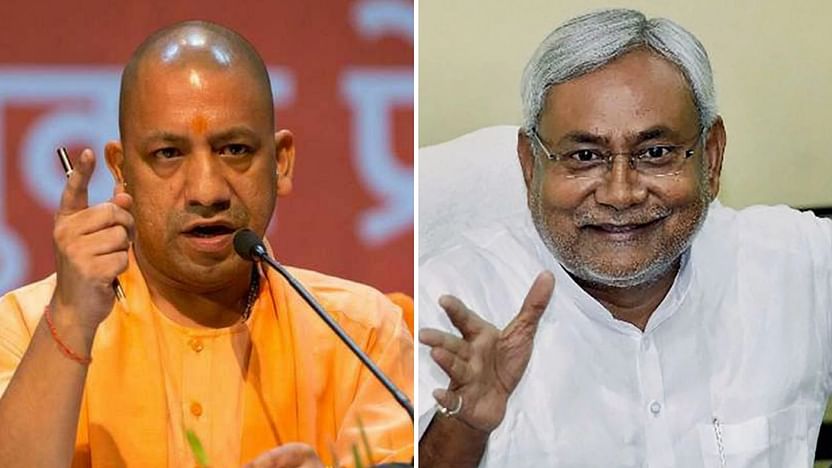Such has been the Indian psyche that states of Uttar Pradesh and Bihar come to mind when one talks of the issues of poverty, lawlessness and underdevelopment, and popular culture- movies, TV shows and other artworks too seem to reinforce such perceptions. The highest level of migration also originates from the states of Uttar Pradesh and Bihar.
At the root of their misery have been some of the most incompetent political leaders-regional satraps that have survived for decades on vote bank politics and the obsolete ideology of socialism that has dragged the two states down. In Uttar Pradesh, the Bahujan Samaj Party (BSP) and Samajwadi Party (SP) were in power for several decades till 2017, while in Bihar, it has been Lalu Prasad Yadav’s RJD and Nitish Kumar’s JD (U) that have been in power all this while.
The supremo-centric/ dynastic political outfits have been at the root of poor governance, but since 2017 when the BJP stormed to power in Uttar Pradesh and Yogi Adityanath took oath as the Chief Minister of UP, there has been a palpable shift in the perception of the state of Uttar Pradesh.
In Bihar, Nitish Kumar somewhat ended the era of jungle raj (lawlessness) that had taken grip of the state during Lalu Prasad Yadav’s rein, but he has shown no appetite for economic advancement. Bihar had never had a thriving industrial sector, and since its bifurcation in 2000 when the mineral-laden, industrially prolific state of Jharkhand got carved out from Bihar, the industrial sector went further downhill.
Investment proposals in Bihar haven’t been awe-inspiring- the Industrial Investment Promotion Policy (IIPP) was launched by the state in the year 2016 and last year Bihar CM Nitish Kumar said that till now investment proposals of only Rs 14,855 crore were received by the state.
On the other hand, Uttar Pradesh CM Yogi had been able to garner whooping investment proposals worth Rs. 2.5 lakh crores in the first year of his tenure itself, that is 2017. The UP Defence Industrial Corridor project has been a phenomenal success too, and investment proposals worth Rs. 50,000 crores were received by the state during the recently concluded Defence Expo 2020 held in Lucknow, Uttar Pradesh.
Helping Uttar Pradesh is the rampant development of Expressways in the state, and Chief Minister Yogi Adityanath plans expressways in every single region of the state by 2022 while there are no such plans in the neighbouring state of Bihar.
Moreover, Uttar Pradesh has been focussing on reforming law and order, and as the state comes out of the lawlessness perpetrated during the previous regimes, it will be able to make an even more vigorous pitch for investments.
The Nitish Kumar government doesn’t even seem to be making a push for industrialisation, and the Chief Minister has time and again declared that Bihar cannot tap private investment unless and until the state is accorded a special status. On the hand, Uttar Pradesh has at least shown the appetite to transform itself with Chief Minister Yogi Adityanath holding Global Investors’ Summits as a part of his ambitions to make the most populous state of India, a US $ 1 trillion economy.
Even now with COVID-19 Pandemic and Beijing’s cover-up forcing Multi-National Companies to shift their businesses out of China, UP Chief Minister Yogi Adityanath has shown much more imaginativeness and geopolitical awareness than Bihar CM Nitish Kumar.
Bihar never made a pitch for companies exiting China to invest in the state, but Uttar Pradesh with similar socio-economic conditions as Bihar, has been wooing American, Japanese and Korean companies to translocate their operations and invest in the most populous state of India.
Uttar Pradesh shows promise and that is why it is gradually leaving Bihar far behind, and there have been hints about Uttar Pradesh powering its way out of poverty with the state’s industrial output overtaking the national average and a sustained rise in power consumption that is often correlated with signs of economic growth.
In other areas too, Uttar Pradesh is performing far better than Bihar. For example, while both the states have traditionally faced agrarian distress despite having the most fertile soils to boost the private sector because they were not able to make full use of the green revolution unlike Haryana and Punjab, Yogi government in Uttar Pradesh has inched ahead of Nitish government in Bihar when it comes to delivering rural welfare schemes.
A strong agricultural sector usually lays the foundation for a strong manufacturing sector and industrialisation is often preceded by a boom in agriculture. It can be safely said that in this sector too, Uttar Pradesh is moving ahead of Bihar.
Similarly, both states do not really have a great track record when it comes to the health sector. But things have started changing in Uttar Pradesh since the Yogi government stormed to power. Japanese Encephalitis- a child killer disease, for example, is getting quickly eradicated in Uttar Pradesh, whereas the Nitish Kumar government remains clueless.
Uttar Pradesh is paying a lot more attention to healthcare than Bihar. While the latter allocates 3.94 per cent of its total expenditure on health, UP spends as much as 5.07 per cent of its total expenditure on this sector. Also, the per capita expenditure on health is lowest in Bihar at Rs. 495 compared to Rs. 733 in Uttar Pradesh.
Not just investment proposals, Uttar Pradesh is looking to break its way out of backwardness on every single front, while Bihar looks set for long-term stagnation due to an uninspiring political leadership that seems to work in a very opaque manner. We rarely find any criticism of how things are not moving ahead in Bihar within the local media out the mainstream media- a reason why Nitish Kumar was able to craft his ‘Susashan Babu’ image even though things haven’t really moved ahead in the state under his regime.
